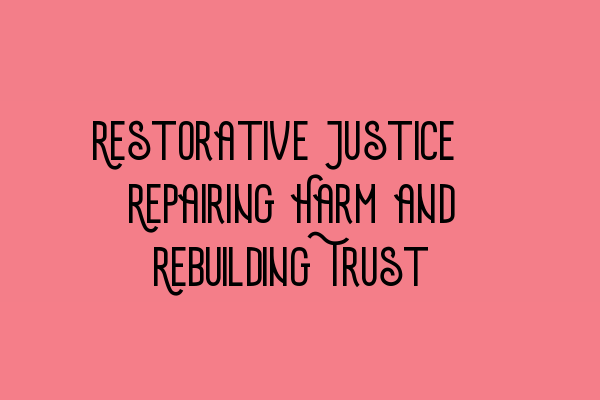Restorative Justice: Repairing Harm and Rebuilding Trust
In the modern criminal justice system, alternative methods of resolving and addressing criminal wrongdoing have gained significant attention. One such approach is restorative justice, which focuses on repairing the harm caused by crime and rebuilding trust between the parties involved. In this blog post, we will explore the principles of restorative justice and its potential benefits in criminal cases.
What is Restorative Justice?
Restorative justice is a process that brings together the victim, the offender, and the community to actively participate in resolving the harm caused by crime. Unlike traditional criminal justice, which focuses primarily on punishment, restorative justice seeks to hold the offender accountable while also addressing the needs of the victim and the community.
Key principles of restorative justice include:
- Inclusion: All parties affected by the crime have the opportunity to participate in the resolution process.
- Voluntariness: Participation in restorative justice is voluntary, ensuring the consent and willingness of the parties involved.
- Empowerment: The process allows for the empowerment of victims, offenders, and the community, giving them a voice in shaping the resolution.
- Accountability: Offenders are encouraged to take responsibility for their actions and make amends for the harm caused.
- Reparation: The focus is on repairing the harm and addressing the needs of the victim, rather than punishment alone.
Restorative justice recognizes that criminal behavior not only affects the victim but also the community as a whole. By involving all stakeholders in the resolution process, it aims to foster healing, reconciliation, and a sense of belonging.
Benefits of Restorative Justice
Restorative justice offers several advantages over traditional approaches to criminal justice. Firstly, it provides a forum for victims to be heard, express their feelings, and seek answers to their questions. This can help alleviate their trauma and provide a sense of closure.
Secondly, restorative justice allows offenders to understand the impact of their actions directly. By engaging in dialogue with the victim, they can gain empathy and develop insight into the consequences of their behavior. This can be a powerful motivator for personal growth and rehabilitation.
Furthermore, restorative justice promotes community involvement and reintegration. By actively participating in the resolution process, community members can contribute to creating safer neighborhoods and foster a sense of collective responsibility.
Applications of Restorative Justice
Restorative justice can be applied in various stages of the criminal justice process, from pre-charge diversion programs to post-conviction initiatives. In some cases, it may even be utilized as an alternative to imprisonment or as a part of a rehabilitation program.
Many jurisdictions have successfully integrated restorative justice practices into their criminal justice systems, including the United Kingdom. It has been particularly effective in cases involving youth offenders, as it focuses on their rehabilitation and the prevention of reoffending.
It is important to note that restorative justice is not a one-size-fits-all solution and may not be appropriate for all cases. However, it presents a valuable alternative to traditional punitive approaches and has the potential to make a positive impact on individuals and communities affected by crime.
If you are interested in learning more about restorative justice or other aspects of criminal law, please check out our related articles:
- SQE 1 Practice Exam Questions
- SQE 1 Practice Mocks FLK1 FLK2
- SQE 2 Preparation Courses
- SQE 1 Preparation Courses
- SRA SQE Exam Dates
At SQE Criminal Law & Practice Law UK, we are committed to providing comprehensive and up-to-date information on various legal topics. Feel free to explore our website for more resources and insights.
Thank you for reading!
